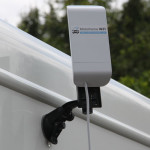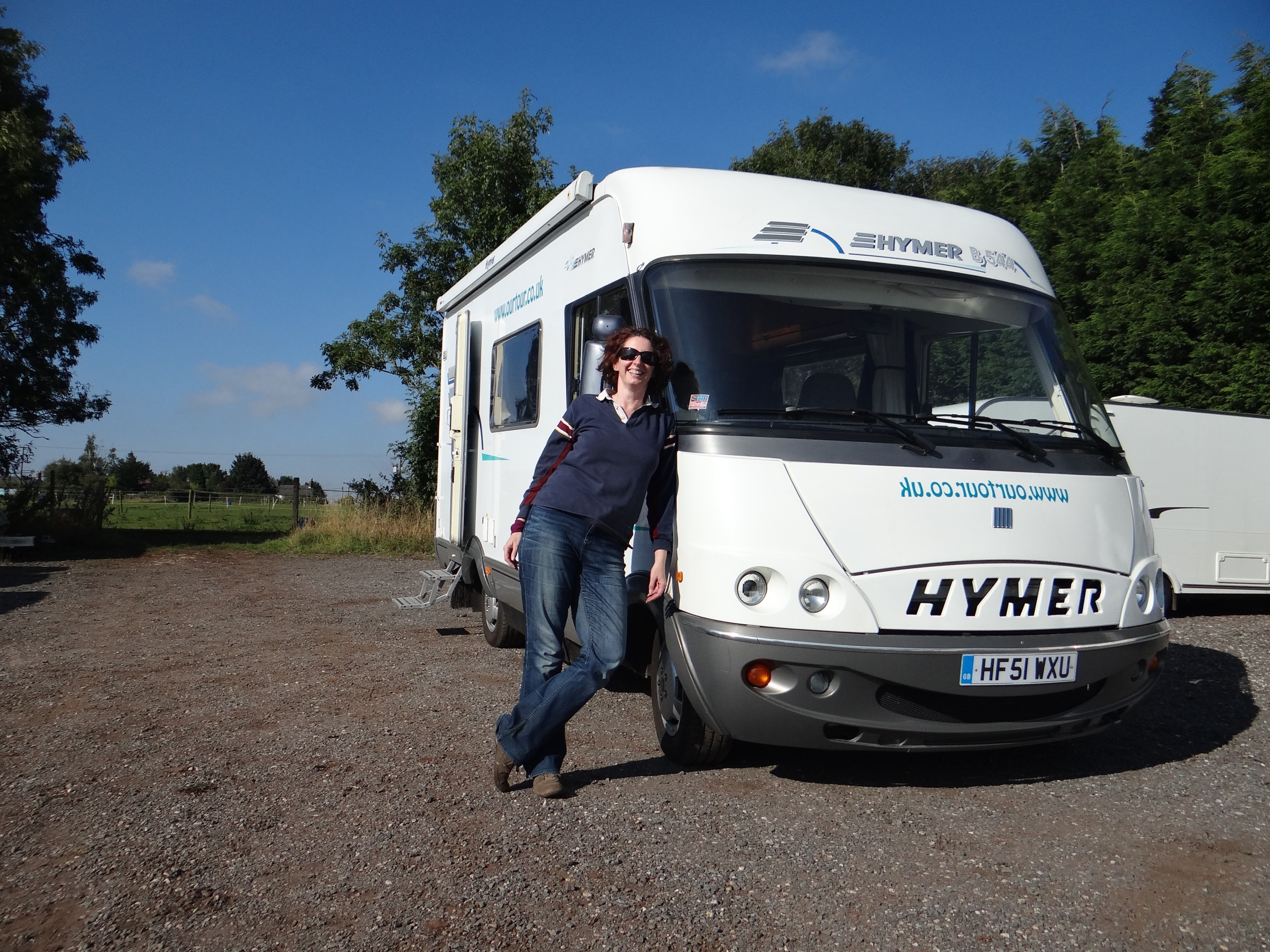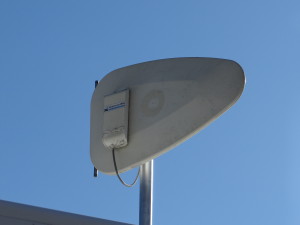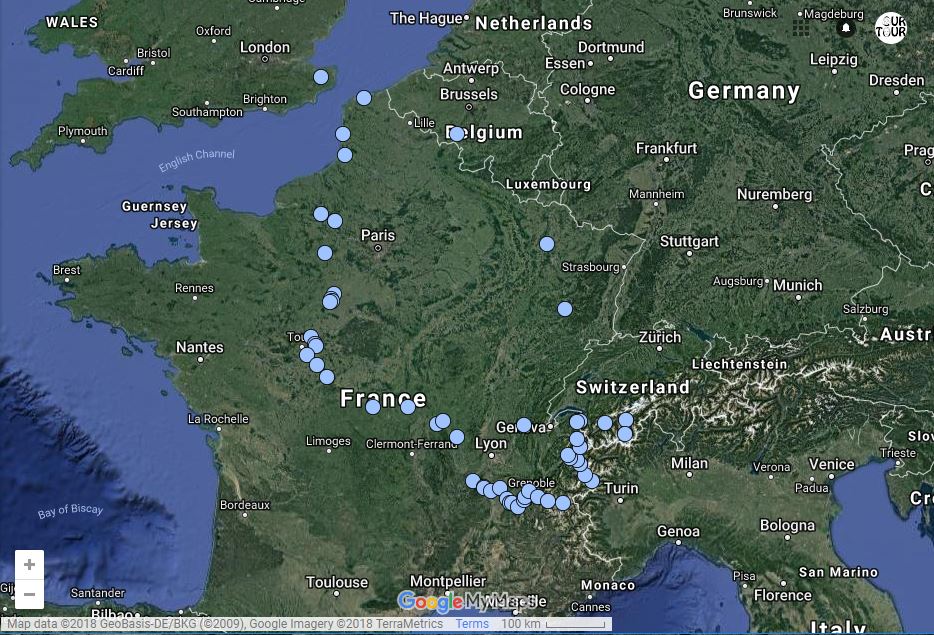Online in a Motorhome – Our 2016 Internet System
 No need to tell you guys how useful and liberating it is to have Internet access when wandering about in your motorhome (or caravan for that matter). Our travels tend to take us out of the UK, where we meander about Europe and North Africa writing blog posts (this one’s coming to you from Sant Feliu de Guixols, a pleasant seaside town on the Mediterranean north of Barcelona). Occasionally we pop in a bit of real work, and kick off video chats with friends and family back home or even on t’other side of the world.
No need to tell you guys how useful and liberating it is to have Internet access when wandering about in your motorhome (or caravan for that matter). Our travels tend to take us out of the UK, where we meander about Europe and North Africa writing blog posts (this one’s coming to you from Sant Feliu de Guixols, a pleasant seaside town on the Mediterranean north of Barcelona). Occasionally we pop in a bit of real work, and kick off video chats with friends and family back home or even on t’other side of the world.
The ideal Internet system for us would look something like this:
- It would be inexpensive and a fixed price per month (max £20 a month) for unlimited bandwidth
- As we intend to travel part-time, we want to use a pay-as-you-go basis, so no contracts
- It would be fast – minimum of 2Mbps per second to allow good quality Skype video calls (for comparison: as of Feb 2015, average UK download speed was 23Mbps)
- It would work everywhere we’re parked, whichever country and regardless of whether we’re in a city, on a mountain pass or up against a desert
- It would be simple to use, it would ‘just work’ everywhere
- We’d be able to access the Internet both from within (or within a few meters of) the motorhome, plus we’d be able to take it with us when we leave the van during the day or evening
That’s the ideal. Having visited about 530 places now, and uploaded blog posts from all but one or two of them, we know this isn’t quite possible, just yet! With the help of experts in this field we have come pretty close, although there are better solutions than ours available – see below.
So, the options we’ve considered over the years for Internet access have been as follows (including combinations of these individual solutions):
 |
Satellite internet. This gives pretty much guaranteed connectivity as long as you have line of sight to the satellite, and are in its service area. It’s not cheap though – the installation cost alone for a roof-mounted system is currently over £3000. We could reduce this using a tripod-mounted system, or bolt a pole to the back of the van and manually aligning the dish each time we move – which wouldn’t be convenient. |
 |
WiFi. Everyone knows this one – it’s the good old ‘pools’ of Internet access provided by cafes, campsites, municipal facilities and so on, which your laptop or mobile phone hooks onto. It’s often locked down so you need a unique code to get onto it, and if you’re any distance from source, your kit might not see the WiFi network at all. WiFi networks are sometimes made available for free, but more likely they’re bundled with another service – so if you buy a drink at a cafe you get the code, or if you’re a BT broadband customer you can use their FON networks as you travel. They usually give a speed good enough for video calls, and are unlimited in terms of the data you can use. |
 |
Cellular Wireless. Most folks know this one now too – it is where your kit has a SIM card in it and connects to the Internet in pretty much the same way as your mobile phone accesses the voice network – seamlessly – you don’t even notice it happening. The difference between this and WiFi is it’s never free of charge, but as much of the Earth is now covered by a mesh of masts broadcasting these networks far and wide, you’re much more likely to be able to easily get access as you move from place to place. |
There’s tons more to it than that, but in the interests of not boring you to death (you must be close by now if you’ve gotten this far), here’s the solution we’re using now and plan to use in 2016 – It’s a combination of WiFi and Cellular Wireless access, similar to what we’ve used in previous years.
- WiFi. When WiFi is available we’re using our old motorhomewifi.com uni-directional USB-connected booster antenna. This enables us to access and maintain decent connection speeds on networks which are more than a few meters away. It’s not perfect though, as you have to aim the antenna in the direction of the network, which is reasonably simple with the aid of a finder utility, but it’s still a bit of a faff especially when after 10 mins you find there’s no network you can access. Omni-directional antennas don’t need pointing at the network, but can’t access distant networks as well with them. Our antenna only lets you access the internet with our USB-connected laptop (for example); we’d need to buy a solution like Connectivity (about £23) to share the Internet access out so both of us could use it at the same time
- Cellular Wireless. We mostly rely on this system which we installed ourselves as described here. It is a combined Huawei 4G MiFi and a roof-mounted 4G booster antenna (note: this doesn’t boost external WiFi signals), both of which came from motorhomewifi.com. At this point a quick disclaimer: the antenna was given to us for free by motorhomewifi.com. That said, it costs £150, and anyone’s reputation is worth far more than that so we’re not going to give it a good review if it’s no good.
Having now used the Cellular Wireless system for a couple of months in the UK, France and Spain, here are our thoughts on it:
- It’s very convenient. The MiFi is always connected to the 12V system so is always powered up, unless we manually switch it off, and creates a private WiFi network in our motorhome all the time, so it takes no time at all to get connected. Note: we manually switch the MiFi off when on an external WiFi network to avoid using it by accident.
- The roof-mounted antenna has enabled us to get 3G networks everywhere outside the UK, including some remote spots. Speed has always been good enough to upload a few MB of images within a maximum of a few minutes.
- On the question of whether I would pay the £150 for the antenna: the answer before setting off would have been no. I’d just use the MiFi and pop it on the roof to get it outside the van’s signal-shielding metal bodywork, or more likely just used the hotspot facility on our aged Android smart phone. The answer now though would be yes: the roof-mounted antenna is MUCH bigger than the antenna in the MiFi or any phone, and the consistent high quality network connectivity has been testament to how well it works as a booster. The antenna is weatherproof too, sitting outside without the need to open a window or skylight.
Cellular Networks
- We’re using Three’s Feel at Home package, which consists of a free-to-get PAYG SIM then (for the option we’ve chosen) £15 a month for 3GB of data. This has worked well for us, although we’re getting through the 3GB in about 20 days, mostly as the system works so well!
- We track data use both on the MiFi screen, but if we access Three’s website through it we can see how much bandwidth we have left, which appears to give a more accurate figure.
- Feel at Home isn’t the perfect roaming solution though, as Three only intend it to be used by people holidaying, not travelling endlessly for months on end so can kill your SIM if they want to. We have multiple SIMs, just in case. Also it’s not as simple as it should be to top up from abroad, and it only works in certain countries. We’ve also found we had to manually select networks on occasion: all of this is well described on the motorhomewifi.com blog.
- In 2016 we’ll travel outside the Feel at Home countries (Germany isn’t currently covered). From past experience we can easily get a local PAYG SIM for a month at a time as we move through for these countries – with no need for a local address or bank account.
- We don’t use the Cellular Wireless system for Skype calls or video streaming from YouTube and so on – just to keep bandwidth use and cost down. How well it would work for this type of high bandwidth access is an unknown for us. Our experience of using a simple USB 3G dongle in Morocco (which came with unlimited bandwidth) was that video calls often worked well on it, so my expectation would be this much larger antenna would generally give an acceptable standard of video call much of the time.
As noted above: we could easily improve the system further. Motorhomewifi.com provide a WiFi antenna which is connected to a device called a router inside the van. This takes the external WiFi network and re-broadcasts it as a private network in the van, making it much simple to just hook up a tablet or two to it with having to fire up a laptop, run Connectify etc. We might consider adding this in future. We recently saw how Mark of wheresfrankie.co.uk had attached a unidirectional antenna to his Status TV aerial so could direct it from inside the van – we could do the same on our sat TV dish – clever stuff.
If you’ve any thoughts or questions, please just pop ’em in a comment below and we’ll do our best to answer ’em. Right, the sun’s coming out over the town, time to head out for a walk down the beach.
Cheers, Jay












You mention travelling in Germany… There is very little free or open wifi in Germany – something to do with privacy laws. Also reading sales of sims to non residents is being highlighted as a problem across europe due to security so we could be seeing the end of the walkup no questions asked sim card purchase.
Hi Steve
I can only go from our experience…
We’ve been across Germany a time or two, always managed to get local SIMs with no trouble. We needed to show our passports most of the time when buying PAYG SIMs in Germany nd other countries, only in Morocco did we they just hand over a package with SIM and dongle in return for cash. We’ve always been able to get a local SIM abroad without a local bank account or local address though, and we’ve never shied away from telling them we are from the UK.
Yup, the majority of WiFi networks are now locked down, not just Germany but most of the countries we visited. That’s not to say open WiFi networks don’t exist (we’re usually too lazy to even look for them much of the time), Spain’s networks are mostly locked but I’m writing this from a municipal network provided unlocked and free of charge. There’s definitely still a place for WiFi in motorhome/travelling Internet access, and it may well become increasingly important as the technology improves, data rates and coverage increase, FON-type sharing arrangements become more popular and the demand for ubiquitous high speed connectivity drives authorities to provide it.
As for the future of cellular connectivity, that again remains to be seen. In theory EU legislation due to come into force in the next year or two should force roaming charges to be removed, and with it the need to buy local SIMs or find UK SIM deals which provide partial protection from roaming charges, like Three’s Feel at Home. The telco corporates have profits to protect of course, and clearly this geographical levelling of the playing field won’t be welcome. Quite how they’ll react and what deals they will offer… who knows? We used to use a deal called EuropaSIM which provided a rebadged Italian Vodafone SIM which roamed across Europe for a decent monthly price. This got canned though, presumably as it was too good a deal, who knows.
For the time being the combination of Feel at Home and local SIMs plus a decent WiFi booster will keep us online. If you know of any better SIM deals though, especially for Germany, we’d love to hear about it!
Cheers, Jay
Thanks for the clear explanation. Very helpful! I hope Steve’s fears do not come true:-(
We spend about nine or ten months of the year travelling around Europe and, like yourselves, use a combination of WiFi and 3/4G. We’ve got the Motorhome wifi set up with the Omni- directional ariel and usually find a signal (finding the password if it’s locked down is another issue). In Greece WiFi is a piece of cake, always free on campsites and tavernas/cafes are happy to give their passwords. In larger cities in other European countries we can usually find some free WiFi. If that fails we use our Europa SIM card in a MiFi device. It’s not strictly true that this card has been “canned” we got ours a few years ago from Motorhome WiFi and, as we’ve kept it topped up it still works fine and for €3 a day (on the days we use it) we get 500mb of Internet, if we exceed this it just slows us down to 32kbs. They are still available but you have to buy them from a Vodafone shop in Italy now (for about €10 I think, check the Europa SIM website). You then need to activate the “smart passport” option and bob’s your uncle. Cheap internet access throughout Europe. We also use the 3 feel at home option but this is not intended for extended use abroad (see their terms and conditions) so we use it sparingly and hope they don’t notice us. We reckon they’ll probably kick us off before we get back to the UK next spring. At the moment we’re stopping for a while on a campsite in Spain where we pay €20 for 30 days unlimited access with bandwidth adequate for streaming live football and downloading movies.
Cracking info on the EuropaSIM Pat – quite right – ours was binned as we stopped topping it up while back in the UK for 2 years. We may well get ourselves to Italy next spring, thanks again! Jay
Hello Jay.
I’ve been waiting for you to write this report. Ive always thought a decent roof mounted antenna was the obvious way to go, and have looked at motorhomewifi’s offering too, but it seems SO expensive.
We have an additional areal that we link to our mifi unit (also with a 3 sim in it). It cost about £20 if i remember rightly and usually manages to make some, albeit slight, improvement. It usually sits on the dashboard, up against the windscreen for convenience, but when we’re really struggling i can stick it out on the roof and point it in a specific direction. It certainly isn’t great.
Can i ask if you’ve done comparisons with and without the antenna plugged in? and if so, how much difference does it make? ..as you can see, i remain to be convinced.
On a seperate note, our fall back position has always been one of those Italian Vodafone Europasims. Ours was working fine last time we used it but that was June – any idea when they stopped offering the deal and whether those that have them can still use them?
Regards, Peter and Elaine (still ‘stuck’ in the UK and dreaming of Portugal)
Hi Peter – for EuropaSIM, see the comment from Pat on this article. The question on whether we’ve compared with and without the antenna is a very good one. Yes, I have done this, but not consistently enough to give a scientific assurance that the antenna gives a good enough improvement to justify the cost. I knew I’d not really be bothered to do it (it would need speed tests with and without the antenna at maybe 10 or 20 locations to get an objective assessment, and even then maybe not conclusive unless spread across enough countries), so instead waited a couple of months and to have visited enough locations to get a subjective assessment in my head before writing the article. In those locations I have trialled with and without the antenna, we’ve seen a good signal and associated speed improvement (but again I didn’t run speed checks) with the antenna attached to the MiFi – I’m personally comfortable this compares very well with our past efforts using a USB dongle mounted on a stick taped to the van window and stuck above the height of the van.
As for the £150, I agree this isn’t cheap. I looked around for alternative 4G/LTE antenna, and I couldn’t find anything which matches the motorhomewifi.com design. It’s low profile – so doesn’t stick in the air raising the hight of the van (the sat dish is higher) unlike some tall, spring-mounted antenna I saw. It has a broad base which self-seals onto the roof for a waterproof fit. It has a well-engineered mounting rod and ‘tighten-up/screw-in-place’ bolt to ensure it doesn’t move. It’s been well thought through – a tidy solution. It’s also new and unique, which is certain to add to the cost as these guys will have to recoup their effort and engineering costs until it becomes widely adopted – same as any cutting-edge kit I guess.
Keep dreamin’!
Cheers, Jay
Great info!
Hi Jay,
We use the EuropaSIM too and have done so for years. Last time I used it in Europe was in late Sept and it was still working fine. I have one of the rare 1gb a day versions. It does cost 6euro per gb but we are heavy internet users.
I’ll add that there is a 60 euro cap on monthly spend per EuropaSIM. It used to be that you could lift the cap but this year that has been removed.
Next time we leave the UK I will try to get a new 500mb EuropaSIM for the times we won’t use up a full gig a day. Its a down side that if you start to use the internet with EuropaSIM it only runs for that day and does not carry over. . . which means even logging on to see if you have a connection means you have spent your daily allowance if you use it or not.
Until Europe sorts out its roaming data packages we will all be messing about with all kinds of ariels and sims and packages to see us through I am sure, but at least step by step its getting better.
I agree. . . all I want is complete coverage of 4G speed over the entirety of Europe on one contract with unlimited downloads. I’d be happy to pay a premium for that.
Cheers
Steve.
Portugal is excellent for mobile broadband, MEO offer a super fast 4g data SIM for €10 with 300MB, but if you top it up with €15 they give you 15gig of data to use within 15 days ! Just perfect for a megabyte sucker like myself ! It works in any unlocked smartphone or mifi router. UK 3 network mifi are now unlocked as default.
Hope you see this!
We have just downloaded Connectify for using when we are caravanning or motor-homing – excellent programme. Very reasonable, especially as they have a ‘Sale’ on so it was 75% off!!!
Thank you
We see it Ann! Thanks for the comment, we appreciate it, happy travels, Jay
Hi, What do you guys do for phone sims?
We have PAYG phone SIMs. When we are abroad one of us is on 3 and the other O2. However we hardly use the phones to make calls, we tend to WhatsApp or Skype call when we have WiFi as it’s free.